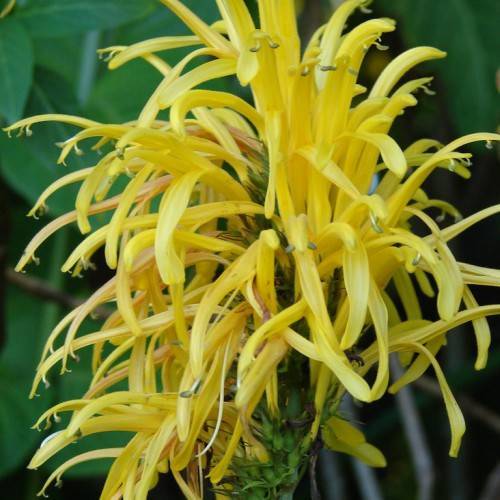
yellow jacobinia
Justicia aurea
Cycle:
Perennial
Watering:
Average
Hardiness Zone:
9 - 11
Flowers:
Flowers
Sun:
Part shade
Leaf:
Yes
Growth Rate:
Low
Maintenance:
Moderate
Salt Tolerant:
Yes
Invasive:
Yes
Care Level:
Medium
watering
Watering for yellow jacobinia, or Justicia aurea, should depend on the season. During the warmer months, water it every 1-2 days to keep the soil moist but not soggy. During the cooler months, reduce the watering frequency to every 3-4 days. Be mindful of your plant's soil health; once every 3-4 days is generally enough unless your plant is showing signs of wilting or drying out. In the hotter months, let the top 1-2 inches of soil dry out between waterings. During winter, make sure the soil is lightly moist but not wet. To check the soil in between waterings, insert your finger into the soil up to the second knuckle. If the soil is dry, water immediately. The best time to water your yellow jacobinia is in the morning, so the leaves can absorb moisture, preventing fungal issues such as powdery mildew.
sunlight
Yellow jacobinia (Justicia aurea) grows best in bright, indirect sunlight. It should receive at least 4-6 hours of sunlight each day. This species does not tolerate intense, direct sunlight or full-on shade, so it's best to find an area of your home or garden with bright light for a few hours but not too much in the hottest part of the day. A south- or east-facing window is ideal.
pruning
Pruning yellow jacobinia (Justicia aurea) depends on the desired size, shape, and flowering habits of the plant. Pruning can be done in early spring (just before new growth begins) or in late winter (before new growth). Since the plant blooms in the summer months, pruning is best done in the early spring. Pruning should be done in small amounts. The plant's branches should be cut just above a node where new foliage and bloom will form, and stems should be cut at an angle. Pruning in the late winter should be limited to removing dead or damaged parts, as well as thinning out overly dense growth. Pruning should be kept to a minimum, just enough to promote new growth and keep the plant from becoming leggy and overcrowded.
